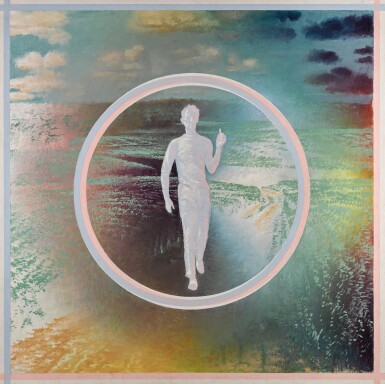Post-War and Contemporary Russian Art from a Private Collection
Post-War and Contemporary Russian Art from a Private Collection

Property from a Private European Collection
Oleg Vassiliev
Figure in a Circle
Auction Closed
December 1, 01:41 PM GMT
Estimate
50,000 - 70,000 GBP
Lot Details
Description
Property from a Private European Collection
Oleg Vassiliev
1931 - 2013
Figure in a Circle
signed and titled in Cyrillic and dated 1976 on the reverse
oil on canvas
Canvas: 123 by 123cm, 48½ by 48½in.
Phillips London, Important Contemporary Russian Art – Property from a Foundation, 28 February 2008, lot 21
Ye.Petrova, N.Kolodzei et al., Oleg Vassiliev: Memory Speaks (Themes and Variations), St Petersburg: Palace Editions, 2004, p.43 illustrated
Similar to his close friend and fellow non-conformist painter Erik Bulatov, Vassiliev’s works are, first and foremost, concerned with the organisation of the pictorial space. The two met while studying at the Surikov State Art Institute in Moscow, with both of their artistic practices shaped strongly by the encounters with members of the older artistic generation, namely Robert Falk, one of the most influential figures within the Russian avant-garde realm, and Vladimir Favorsky, theoretician, wood engraver and former Rector at Vkhutemas-Vkhutein.
The present work is a quintessential example of Vassiliev’s experimentation with the viewer’s perception of space. The light blue and pink lines clearly delineate the canvas borders, yet, the addition of a circular shape, enclosing in it a male figure walking towards the viewer, all depicted against the background of a faded landscape, complicates and subverts this initial, seemingly uncontroversial, delineation.
Notable here are Vassiliev’s trademark shimmering colours, visible in the rendering of both the landscape and the figure. The latter most likely depicts the artist himself, the painting filled with introversion and self-reflection. As Vassiliev noted, ‘…especially when I worked in nature. I wanted to include in the picture not only what was in front of me, but also impressions of a passageway to a selected place’ (Oleg Vassiliev. Memory Speaks: Themes and Variations, St Petersburg: Palace Editions, 2004, p.24). Writer Andrew Solomon has further aptly commented: ‘He documents lost worlds, describing the ineffable power of what has been, a power inherent in its vanishing. It is an art of longing and of beauty. When you view his work, you feel as though memory itself is realised before you, and you look with the artist’s nostalgia at scenes you never lived or experienced’ (ibid., p.14).
